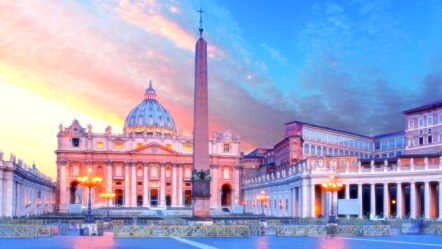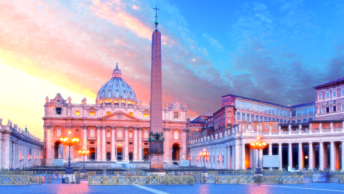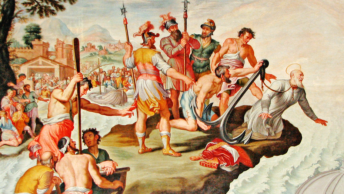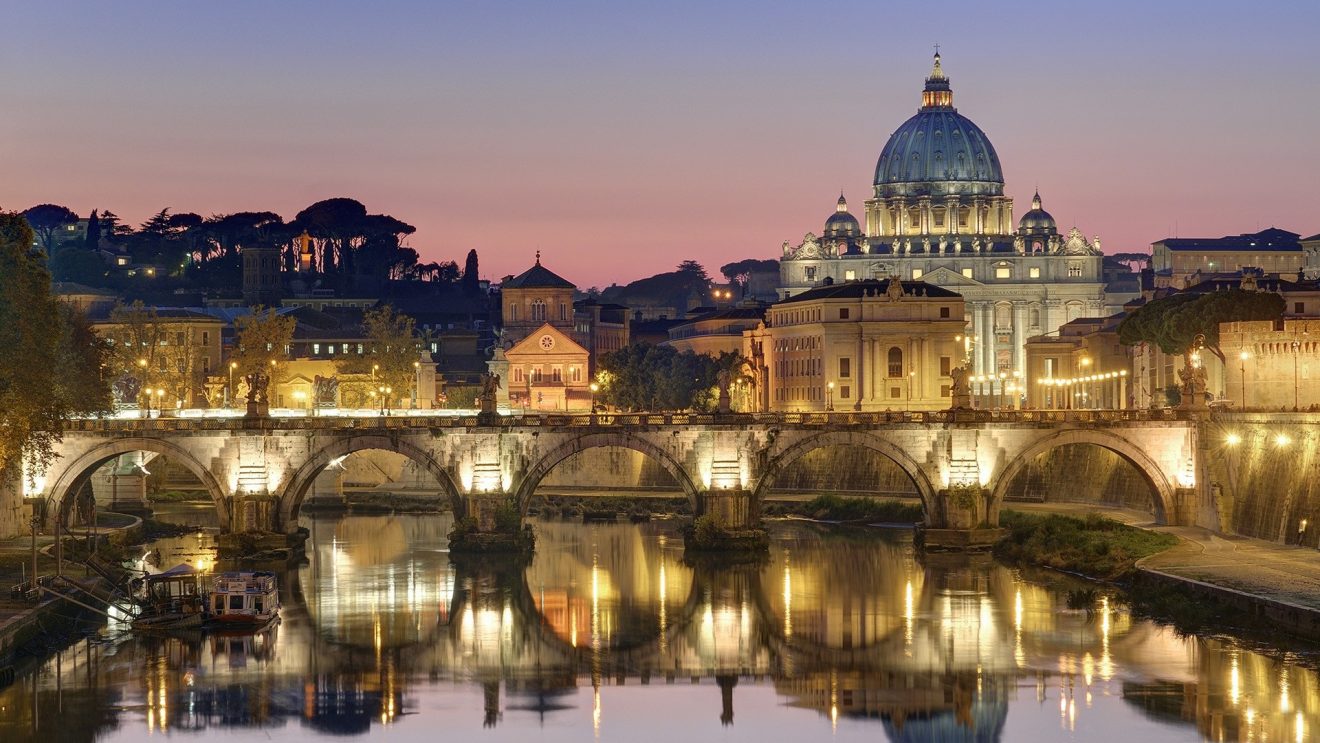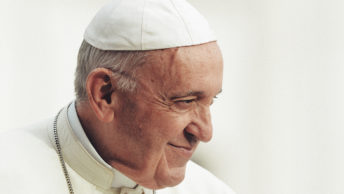The direction of the Roman Catholic Church under Pope Francis has caused conservative Catholics to express grave concerns. The Church synod last October gave rise to fears about the planned successor synod this fall. Many other issues have raised worries about the future of the Church under Pope Francis’s authority: his description of the U.S. Catholic church as “reactionary”; the Vatican’s missive about blessing individuals involved in same-sex relationships; his removal of conservative bishops and cardinals from positions of authority; his hostility to the Latin Mass; his criticism of capitalism as creating inequality; his openness to Communion for divorced and civilly remarried Catholics; and his warnings of a global crisis caused by climate change.
Pope Francis appears intent on taking the Church in new directions. He has won praise from Church liberals for his suggestions that women and gays should play larger roles in the church. His severest critics accuse him of undermining traditional doctrine related to sin, Church hierarchy and the magisterium of his office.
How Left-Wing?
Pope Francis is not a supporter of liberation theology. Nor is he a Marxist. As a Jesuit in Argentina, he opposed liberation theology, alienating many in the Jesuit order in his country. Instead, Pope Francis sees himself as an evangelical missionary concerned with the poor and the alienated. He believes that the Church needs to relieve the suffering of the poor and be more inclusive of alienated communities.
At a time when institutions and authority have been subverted by progressives seeking diversity, equity and inclusion, conservative Catholics are rightly concerned that the Church is becoming yet another institution about to fall to a progressive takeover. Pope Francis has not been reassuring in his messages condemning capitalism, his warnings of catastrophic climate change, and his tepid objections to ongoing repression of the Church and its priests in dictatorial countries. His agenda aligns with a progressive faith that capitalism is bad, existing institutional hierarchies are enemies of equity, and inclusivity should be a goal in itself.
Pope Francis’s faith as a Christian and his commitment to spreading Jesus’s message of redemption are unimpeachable. Traditional Catholics can appreciate his steadfast opposition to abortion and, more recently, surrogate motherhood.
Concerning abortion, Pope Francis has said, “Abortion is murder. . .. It’s a human life, period.” He repeated the Church’s categorical opposition to abortion in 2013, placing abortion in the context of a “culture of waste that enslaves the hearts and minds of so many” at a very high cost: “It asks for the elimination of human beings. . .. Our response to this mentality is a decisive and unreserved ‘yes’ to life.” The following year, 2014, Pope Francis reaffirmed this position by stating that life must be protected from the moment of conception. He urges clergy and laity to show compassion to those women who have experienced an abortion but warned against “false compassion to those who believe abortion benefits women.”
In January 2024, following the synod, Pope Francis called for a universal ban on surrogate motherhood. His message was direct and unequivocal: “I consider despicable the practice of so-called surrogate motherhood, which represents a grave violation of the dignity of the woman and the child, based on the exploitation of situations of the mother’s material needs.”
On the other hand, Pope Francis has removed critics such as Bishop Joseph Strickland and Cardinal Raymond Leo Burke, who he believes oppose his program of inclusion.
He has promoted in their place prelates who support his agenda. His goal of inclusivity toward homosexuals and women minimizes longstanding tradition and doctrine on the sin of homosexuality and the prohibition of women as deacons and priests. He is like many progressives who call for inclusivity, while excluding their critics.
The 2023 Synod
Presumably to nudge the Church toward change, Pope Francis called for a Church synod to be held in Rome last fall, continuing a process begun at the diocesan level in 2021. A follow-up synod is scheduled to occur this fall. For some outside observers, the 2023 synod was not eventful. But critics have made a good case that the 2023 synod was of great importance for the future of the Church.
The nearly monthlong Bishops’ Synod on Synodality held in October 2023 was the first assembly of its kind. Synods, in which bishops gather from many regions to advise the Pope, date back to the earliest days of the Church. Pope Francis added a new dimension to the 2023 synod by inviting laity and women to attend as voting members. More than a quarter of the voting members were not bishops, including 54 women who were laity or from religious orders. A third of the 364 voting members were directly appointed by the Pope.
More than 1,150 amendments were proposed for the text of the resulting document, entitled “A Synodal Church in Mission.” Each paragraph of the text was approved by at least a two-thirds majority vote. At the core of this ambitious document was the call for “co-responsibility” among those believing in the evangelical mission of the Church. The final text included proposals on how to achieve the goal of “co- responsibility.”
Especially important were proposals to establish new ministries for the laity, increase lay involvement in Church decision-making, ascertain the laity’s evaluation of bishops’ performance, change the way the Church discerns “controversial” issues, and expand synodal assemblies in the future.
The document defined synodality as coming together in assembly at different ecclesial levels, listening to one another, engaging in communal discernment, and building a consensus. While calling for consensus building, the document stated, “Some fear that they will be forced to change; others fear that nothing will change and there will be too little courage to move in the rhythm of the living Tradition. Some perplexity and opposition also hide the fear of losing power and the privileges that come with it.” Cardinal Mario Grech, head of the Secretariat for the synod, summarized the document to the press following the assembly, saying, “This is the approach of Jesus, to create spaces for everyone so that no one feels excluded.”
The voting on the text showed division within the synod. Two paragraphs in particular raised concerns for some voting members. The first proposed that “theological and pastoral research on women’s access to the diaconate should be continued.” The second controversial paragraph called for “deeper reflection” on the diaconate as “a proper and permanent degree of the hierarchy” and a need to “illuminate the issue of women’s access to the diaconate.”
Sixty-seven members voted against both proposals, which nevertheless were passed overwhelmingly by the 364 delegates. The dissenters fear a slippery slope of allowing women to be Church deacons and ultimately priests, although the Pope assured delegates that female priesthood is off the table.
The working document of the synod included the term “LGBTQ+ People,” but this term did not appear in the final document that was voted on. The final summary report expressed the assembly’s “closeness and support to all those who experience a condition of loneliness” because of “fidelity to the Church’s tradition and magisterium in marriage and sexual ethics.”
Push for More Inclusivity
One paragraph in the final document drew particular attention: “In different ways, people who feel marginalized or excluded because of their marriage status, identity or sexuality, also ask to be heard and accompanied.” These words refer at least in part to gays, without using the acronym LBGT.
The final document called for more study on these issues, which are to be explored and decided on at the synod this fall. For those advocating a stronger statement on LBGT inclusion, the final document was a letdown. For example, Francis DeBernardo, executive director of New Ways Ministry, which ministers to LGBT Catholics, told the press that the report “greatly disappoints” those who expected something more positive. He added that it is “important for the Catholic Church to live up to its best ideals of being an enlarged tent where all are welcome, all are respected, and all are treated equally.”
The document expresses Pope Francis’s belief that the core of Roman Catholic evangelization should be built around “inclusion.” This is a view of the Catholic Church as an “enlarged tent” (in DeBernardo’s formulation), inclusive of unrepentant sinners.
The language on considering the inclusion of women in the diaconate drew the most dissent, but the demand for women to become deacons gained momentum within the synod and the final document. When asked at a news conference about the number of dissenting votes on the paragraphs related to women deacons, Cardinal Jean-Claude Hollerich, one of the organizers of the synod, got it right when he noted that “the resistance is not so great as people have thought.” After all, the paragraphs passed easily.
More Input by Laity
The real significance of the document came in the affirmation for laity inclusion in ecclesial decision- making and for expanding synodal assemblies and bodies in the Church. Specifically, the synod called for continental assemblies to be recognized and for the implementation of synodality at regional and national levels. The final synod document stated that local church councils need to be realized as well.
The October synod included many non-bishops, including lay men and women. These lay participants were given a voice and voting privileges at the synod. The document welcomed this inclusion and expressed the “urgent need to ensure that women can participate in decision-making processes and assume roles of responsibility in pastoral care and ministry,” specifically referencing Pope Francis’s recent appointment of several women to positions of responsibility in the Roman Curia.
In 2022, Pope Francis had released the statement Praedicate evangelium (“Preach the Gospel”), which opened the door for laity to head administrative departments (renamed dicasteries) that help the pontiff to govern Church institutions. Francis proclaimed that any qualified Catholic, including laity, could head a dicastery. His 2022 reform broke the link between ordination to the priesthood and Church governance.
The synod sought to ensure that this reform proceeds by recommending that women be included at all levels of the Church and that canon law be adapted accordingly. The final report urged the necessity to “carefully examine whether it is appropriate to ordain the prelates of the Roman Curia as bishops.” The inclusion of the non- ordained in the Roman Curia (the Vatican administrative state) was welcomed by reformers and caused anxiety about a slippery slope to Anglicanism.
Notwithstanding the controversies, some reforms to allow a greater role for the laity and women in the Church may well be desirable and overdue.
The summary report that came out of the 2023 assembly is a working document for the Vatican-called assembly to be held in October 2024. Concrete proposals will be voted on this October, and the final text will be presented to the Pope for his consideration and approval. The second synod document will present recommendations for Pope Francis to act on.
While progressives were disappointed that homosexuality or LGBT was not explicitly mentioned in the text of the 2023 synodal document, conservatives were much more vociferous in their criticism of the synod. Many conservative Catholic bishops and laypeople felt from the outset of the synod that they were being relegated to the sidelines. The New York Times reported that before the synod met, Cardinal Burke and other traditionalist prelates “made public an exchange of letters with Francis in which they aired grave doubts about the legitimacy” of the synod. They urged the Pope to close the door on issues such as women deacons and priests and blessing same-sex marriages.
Confusion on Same-Sex Blessings
In response to those requests, Pope Francis signed a statement of the Church’s position that a sanctified marriage may exist only between a man and woman but added that priests could exercise “pastoral charity” when requests came to them for blessing gay couples. This statement, entitled Fiducia supplicans (“Supplicating Trust”), was issued in December 2023 by the Holy See’s Dicastery for the Doctrine of the Faith. Headlines around the world magnified and exaggerated the statement, causing considerable confusion. Shortly thereafter, news broke that the prefect of the issuing Dicastery, Argentine Cardinal Victor Manuel Fernández, had published a book in 1989 that many considered sexually explicit and inappropriate coming from a priest.
Following a major backlash from African and other bishops, the Dicastery clarified that a blessing of a same- sex couple is not the same as a marriage sacrament and that a blessing should not be given to the ceremony of a same-sex union, but could be imparted during a meeting with a priest, a visit to a shrine, or during a pilgrimage or a prayer recited in a group.In other words, such blessings depend on “context.” Both Dicastery statements actually confirm traditional Church doctrine about sex and marriage and could have the effect of restraining the 2024 synod from opening the door to gay unions for Catholics.
In a hopeful development for conservatives, Cardinal Fernández announced in January that his Dicastery is writing “a very important document on human dignity” that contains “a strong criticism” of immoral trends in contemporary society, including “sex-change surgery, surrogacy, and gender ideology.”
‘Mission’ is Not Only for the Poor
Although those participating in the synod were asked not to speak about differences, multiple conservative theologians warned in various venues of the implications of the working document that came out of the assembly. Bishop Robert Barron of Winona-Rochester, Minnesota, while not overtly critical of the synod or the working document, wrote on the Catholic website Word on Fire that “Practically everyone at the synod held that those whose sexual lives are outside the norm should be treated with love and respect,” but many attending the synod believe that “the truth of the Church’s moral teaching in regard to sexuality ought never to be set aside.”
Bishop Barron observed that the term “mission” as used at the synod seemed more often about “social justice and the betterment of the economic and political situation of the poor,” while “references to sin, grace, redemption, cross, resurrection, eternal life, and salvation” were notably absent in the working document.
Bishop Barron’s concerns about differing roles of the clergy and the laity and about the true mission of the Church were raised by other critics. They will be discussed in the next issue of the Mindszenty Report, along with reasons for optimism about younger Catholics.

